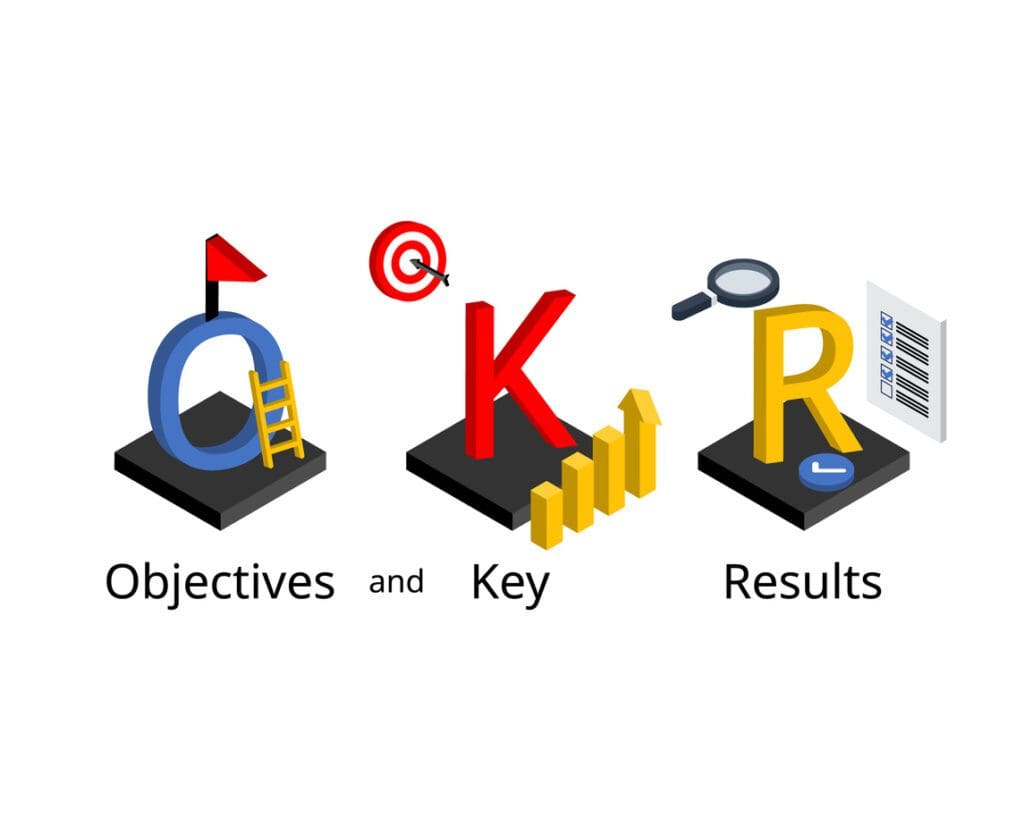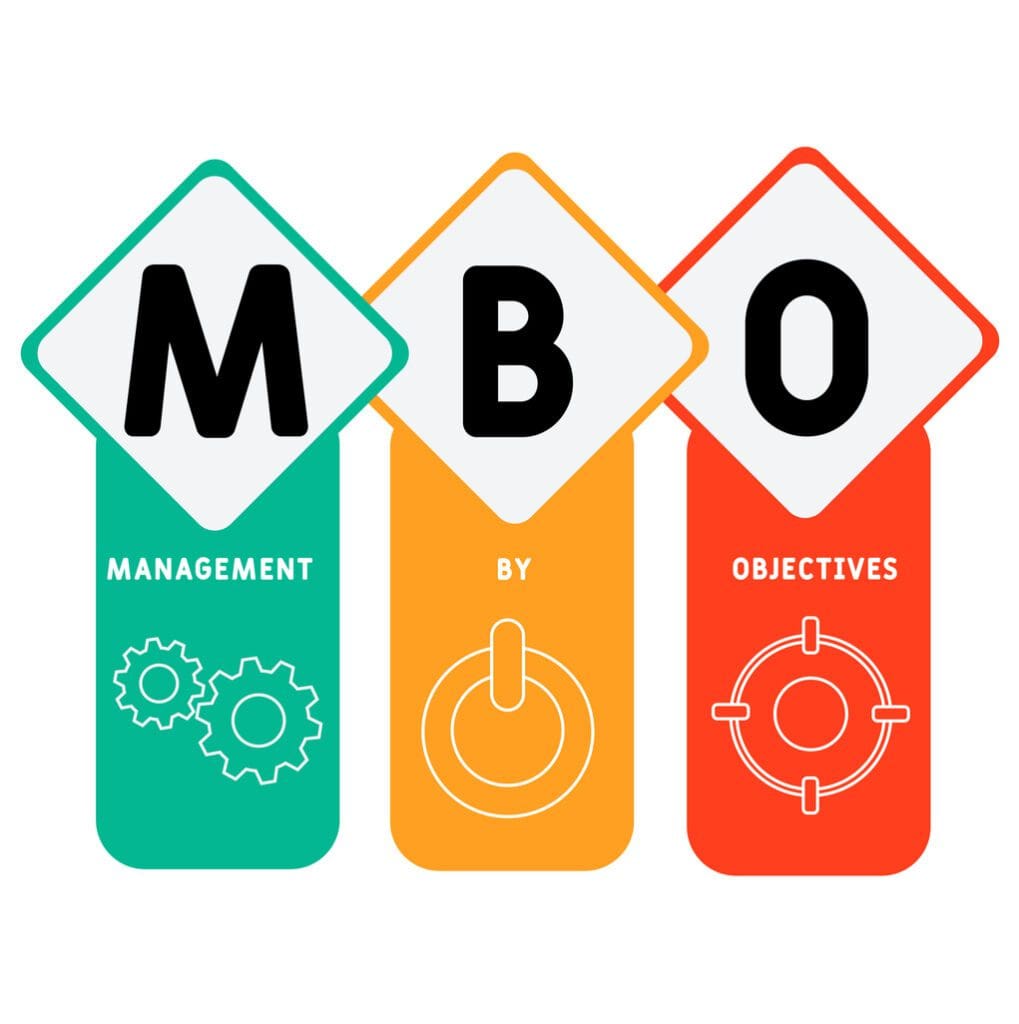Table of Contents
Choosing Your Business Champion: OKR, KPI or MBO
Goal setting is critical to measuring organisational performance. It helps businesses and employees stay focused on achieving high-level goals and objectives. However, choosing the right goal-setting framework for your business can be overwhelming, as various frameworks are available.
In this blog, we will explore the differences between Management by Objectives (MBOs), Objectives and Key Results (OKRs), and Key Performance Indicators (KPIs) to help you choose the best framework for your business needs.
Management By Objectives (MBO)
Management by Objectives (MBO) is a goal-setting framework developed by Peter Drucker in 1954. MBOs focus on aligning organisational goals with employee performance reviews. This framework involves setting specific, measurable, attainable, relevant, and time-bound (SMART) goals.
How to Set MBO Framework
To set up an MBO framework for your business, you can follow these steps:
- The first step is to establish the overall goals and objectives of the organisation. These should be specific, measurable, achievable, and aligned with the company’s vision and mission.
- Once organisational goals are established, they must be communicated to employees.
- After communicating organisational goals to employees, it is time to set individual goals.
- Once individual goals are established, employees and managers should work together to develop action plans for achieving them.
- Regular progress reviews should be conducted to monitor progress towards achieving individual goals.
- Providing regular feedback is essential to the success of the MBO framework.
By following these steps, you can establish an effective MBO framework for your business that aligns individual goals with the organisation’s overall goals.
Advantages of MBO
MBO ensures that individual goals are aligned with the organisation’s overall goals, which helps improve organisational performance.
Clarifying what is expected of employees and how their performance will be evaluated can help improve motivation and job satisfaction.
Collaboration between employees and managers can lead to improved communication and teamwork.
Helps to identify performance gaps and provides a framework for addressing them, which can lead to improved individual and organisational performance.
Used as a tool for employee development by providing opportunities for employees to improve their skills and knowledge in areas relevant to their job performance.
Objectives and Key Results (OKR)
Objectives and Key Results (OKRs) are goal-setting frameworks that differ from MBOs in emphasising ambitious and long-term goals. OKRs focus on setting objectives and measuring key results to achieve those objectives. This framework encourages teams to set ambitious goals and prioritise them based on their importance to the business.


Advantages of OKRs
One of the advantages of OKRs is that they encourage organisations to set ambitious and long-term goals. Organisations can achieve significant progress towards their vision and mission by focusing on objectives that stretch beyond the current quarter or fiscal year.
OKRs also help to align the entire organisation towards a common goal. By setting relevant objectives for all departments and teams, OKRs help break down silos and promote collaboration. Additionally, OKRs provide a transparent and measurable way to track progress towards achieving objectives.
How to set effective OKRs for your business
To set effective OKRs for your business, you need to follow a few best practices.
- Firstly, you must ensure that your objectives are specific, measurable, achievable, relevant, and time-bound (SMART).
- Secondly, you must ensure that your key results are measurable and aligned with the objectives.
- Thirdly, you must communicate the OKRs to all stakeholders and ensure everyone understands how their work contributes to achieving the objectives.
Examples of companies that use OKRs as their goal-setting method
OKRs have become increasingly popular in recent years, and many companies use them as their primary goal-setting method. Some examples of companies that use OKRs include Google, LinkedIn, and Spotify.
Limitations of OKRs
One of the limitations of OKRs is that they may not be suitable for risk-averse businesses. Because OKRs encourage ambitious and long-term goals, they may need to prioritise stability and predictability over growth.
Key Performance Indicators (KPI)
Key Performance Indicators (KPIs) are a goal-setting framework that focuses on measuring progress towards achieving organisational goals. This framework involves setting metrics that can be quantified and analysed to track progress towards achieving business objectives.
KPIs can measure various business activities, such as sales performance, customer satisfaction, employee engagement, and financial performance. The metrics used as KPIs should be relevant, specific, and measurable.


Advantages of KPIs
One of the main advantages of KPIs is that they provide a measurable way to track progress towards achieving organisational goals. KPIs can help identify areas that require improvement and provide insights into optimising business processes.
KPIs are also useful for communicating progress to stakeholders. By sharing KPI data with stakeholders, businesses can demonstrate their performance and build trust with customers, investors, and employees.
How to set effective KPIs for your business
To set effective KPIs for your business, you need to follow a few best practices to set effective KPIs for your business.
- Firstly, you need to identify the organisational goals that you want to achieve.
- Secondly, you need to identify the metrics that will help you measure progress towards achieving those goals.
- Thirdly, you must ensure the metrics are specific, measurable, and relevant to the goals.
- Lastly, you need to track the metrics regularly and adjust them as necessary.
Examples of KPIs used in different industries
KPIs can be used in a variety of industries, including Healthcare, Finance, Marketing and many more, for a variety of purposes, Including Sales growth, Customer acquisition cost, Average transaction value, Patient satisfaction scores, Patient outcomes, Defective product rate, Supply chain cost, Return on investment (ROI), Profit margin, Website traffic, Conversion rate, Social media engagement and many more.
| Framework | Focus | Application |
| OKR (Objectives and Key Results) | Aspirational Objectives and Measurable Key Results | Used to set ambitious goals that drive progress and innovation |
| KPI (Key Performance Indicators) | Specific Metrics to Measure Performance | Used to track progress towards specific business objectives |
| MBO (Management by Objectives) | Collaborative Goal Setting and Progress Tracking | Used to set goals and objectives in collaboration with employees, with regular progress check-ins |
OKRs vs KPIs vs MBOs
When deciding between OKRs, KPIs, and MBOs, it’s essential to consider their purpose, focus, and outcome. While OKRs encourage ambitious and long-term goals, KPIs measure progress towards achieving objectives. MBOs align employee goals with organisational objectives, providing a basis for performance appraisal.
To choose the right goal-setting framework for your business, it’s important to consider factors such as organisational size, industry and culture. Some businesses use a combination of these frameworks to achieve their goals. Aligning goals with organisational strategies is crucial for achieving success.
Now that we have discussed each framework separately, let’s compare them and see which fits your business needs best.
Purpose
MBOs and OKRs share a similar purpose of aligning individual goals with organisational goals. MBOs are more focused on performance management, while OKRs focus on achieving ambitious and long-term goals. On the other hand, KPIs measure progress towards achieving organisational goals.
Focus
MBOs focus on individual employee goals and performance, while OKRs focus on company-wide goals. On the other hand, KPIs focus on measuring performance in a specific area, such as sales, marketing, or finance.
Outcome
MBOs aim to improve individual employee performance, OKRs aim to drive the company towards ambitious goals, and KPIs aim to measure performance and progress towards achieving organisational goals.
Review Process
The review process in OKR, KPI, and MBO frameworks involves assessing progress towards goals and objectives.
- OKR reviews are often collaborative and help identify improvement areas and innovation opportunities.
- KPI reviews are frequent and focus on specific metrics, guiding decision-making.
- MBO involves a collaborative goal-setting process, with regular progress reviews and feedback provided by managers.
Despite some differences in the review processes, the goal remains to assess progress and make adjustments to improve business performance.
Flexibility
OKR is the most flexible of the three frameworks, as it allows for greater flexibility in goal-setting and regular adjustments of goals and priorities.
KPIs are less flexible than OKRs as they focus on specific metrics related to established objectives.
MBO involves a collaborative goal-setting process that is somewhat flexible but with a focus on specific goals and progress tracking.
| Framework | Purpose | Focus | Outcome | Review Process | Flexibility | Use with KPIs |
| MBOs | Align individual goals with organisational goals and improve employee performance | Individual employee goals and performance | Improved individual employee performance | collaborative goal-setting process, with regular progress reviews and feedback | Less flexible, more focused on specific goals | Often OKRs used in conjunction with KPIs to track progress |
| OKRs | Align company-wide goals and achieve ambitious and long-term goals | Company-wide goals | Drive the company towards ambitious goals | often collaborative and help to identify areas of improvement | More flexible allows for changes in direction and priorities | Often OKRs used in conjunction with KPIs to track progress |
| KPIs | KPIs Measure progress towards achieving organisational goals | Specific area (e.g. sales, marketing, finance). | Measure performance and progress towards achieving organisational goals. | Frequent and focus on specific metrics | Can be flexible depending on the tracked metrics. | Can be used in conjunction with MBOs or OKRs to provide a more holistic view of performance. |
Factors to Consider
- When deciding which framework to use, consider your business size, industry, and culture.
- If your business is risk-averse and prefers conservative goals, MBOs may be a better fit.
- If your business is ambitious and looking to achieve long-term goals, OKRs may be the way to go.
- If your business is focused on measuring progress towards achieving organisational goals, KPIs may be the best option.
Examples
Many companies use a combination of these frameworks to set and measure performance towards achieving their goals. For example, Google uses OKRs, Microsoft uses MBOs, and Coca-Cola uses KPIs. Some companies, such as Amazon, use a combination of OKRs and KPIs to achieve their goals.
Choosing the Right Goal-Setting Framework for Your Business
When choosing a framework, involve your employees in the process. This helps them understand the company’s goals and how their work contributes to achieving them.
Additionally, use data-driven metrics to measure performance and adjust goals accordingly. This ensures that your goals are effective and driving your business forward.
Conclusion
In conclusion, goal setting is crucial for business success. MBOs, OKRs, and KPIs are popular frameworks for setting and measuring performance towards achieving organisational goals. Each framework has advantages and limitations, and choosing the right one for your business needs is important. Consider your organisational goals, risk tolerance, and ambition when deciding which framework to use. Remember, the goal is to set effective goals that drive your business forward.



